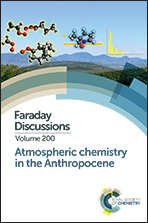Using advanced mass spectrometry techniques to fully characterize atmospheric organic carbon: current capabilities and remaining gaps
Abstract
Organic compounds in the atmosphere vary widely in their molecular composition and chemical properties, so no single instrument can reasonably measure the entire range of ambient compounds. Over the past decade, a new generation of in situ, field-deployable mass spectrometers has dramatically improved our ability to detect, identify, and quantify these organic compounds, but no systematic approach has been developed to assess the extent to which currently available tools capture the entire space of chemical identity and properties that is expected in the atmosphere. Reduced-parameter frameworks that have been developed to describe atmospheric mixtures are exploited here to characterize the range of chemical properties accessed by a suite of instruments. Multiple chemical spaces (e.g. oxidation state of carbon vs. volatility, and oxygen number vs. carbon number) were populated with ions measured by several mass spectrometers, with gas- and particle-phase α-pinene oxidation products serving as the test mixture of organic compounds. Few gaps are observed in the coverage of the parameter spaces by the instruments employed in this work, though the full extent to which comprehensive measurement was achieved is difficult to assess due to uncertainty in the composition of the mixture. Overlaps between individual ions and regions in parameter space were identified, both between gas- and particle-phase measurements, and within each phase. These overlaps were conservatively found to account for little (<10%) of the measured mass. However, challenges in identifying overlaps and in accurately converting molecular formulas into chemical properties (such as volatility or reactivity) highlight a continued need to incorporate structural information into atmospheric measurements.
- This article is part of the themed collection: Atmospheric chemistry in the Anthropocene


 Please wait while we load your content...
Please wait while we load your content...